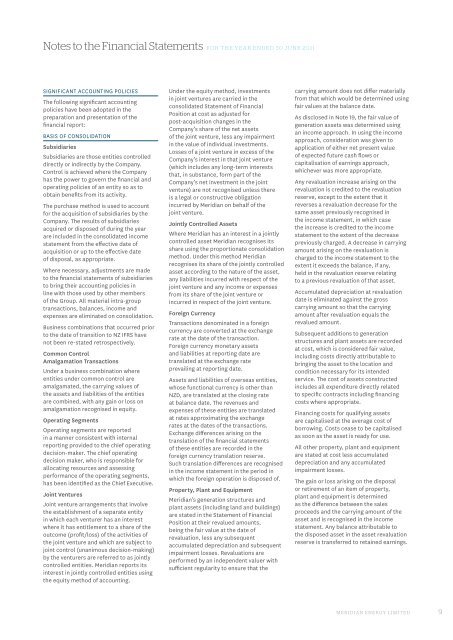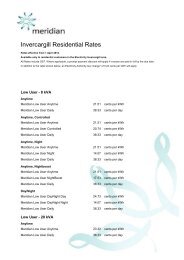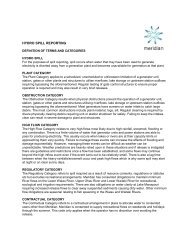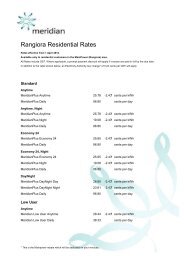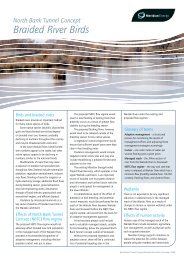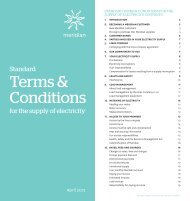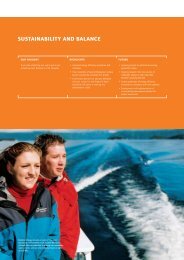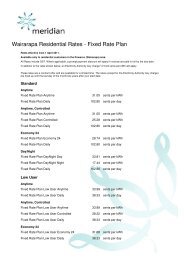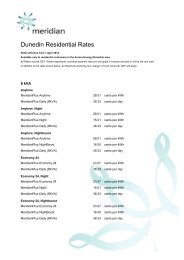Annual report financial statements - Meridian Energy
Annual report financial statements - Meridian Energy
Annual report financial statements - Meridian Energy
You also want an ePaper? Increase the reach of your titles
YUMPU automatically turns print PDFs into web optimized ePapers that Google loves.
Notes to the Financial Statements FOR THE YEAR ENDED 30 JUNE 2011<br />
Significant Accounting Policies<br />
The following significant accounting<br />
policies have been adopted in the<br />
preparation and presentation of the<br />
<strong>financial</strong> <strong>report</strong>:<br />
Basis of Consolidation<br />
Subsidiaries<br />
Subsidiaries are those entities controlled<br />
directly or indirectly by the Company.<br />
Control is achieved where the Company<br />
has the power to govern the <strong>financial</strong> and<br />
operating policies of an entity so as to<br />
obtain benefits from its activity.<br />
The purchase method is used to account<br />
for the acquisition of subsidiaries by the<br />
Company. The results of subsidiaries<br />
acquired or disposed of during the year<br />
are included in the consolidated income<br />
statement from the effective date of<br />
acquisition or up to the effective date<br />
of disposal, as appropriate.<br />
Where necessary, adjustments are made<br />
to the <strong>financial</strong> <strong>statements</strong> of subsidiaries<br />
to bring their accounting policies in<br />
line with those used by other members<br />
of the Group. All material intra-group<br />
transactions, balances, income and<br />
expenses are eliminated on consolidation.<br />
Business combinations that occurred prior<br />
to the date of transition to NZ IFRS have<br />
not been re-stated retrospectively.<br />
Common Control<br />
Amalgamation Transactions<br />
Under a business combination where<br />
entities under common control are<br />
amalgamated, the carrying values of<br />
the assets and liabilities of the entities<br />
are combined, with any gain or loss on<br />
amalgamation recognised in equity.<br />
Operating Segments<br />
Operating segments are <strong>report</strong>ed<br />
in a manner consistent with internal<br />
<strong>report</strong>ing provided to the chief operating<br />
decision-maker. The chief operating<br />
decision maker, who is responsible for<br />
allocating resources and assessing<br />
performance of the operating segments,<br />
has been identified as the Chief Executive.<br />
Joint Ventures<br />
Joint venture arrangements that involve<br />
the establishment of a separate entity<br />
in which each venturer has an interest<br />
where it has entitlement to a share of the<br />
outcome (profit/loss) of the activities of<br />
the joint venture and which are subject to<br />
joint control (unanimous decision-making)<br />
by the venturers are referred to as jointly<br />
controlled entities. <strong>Meridian</strong> <strong>report</strong>s its<br />
interest in jointly controlled entities using<br />
the equity method of accounting.<br />
Under the equity method, investments<br />
in joint ventures are carried in the<br />
consolidated Statement of Financial<br />
Position at cost as adjusted for<br />
post-acquisition changes in the<br />
Company’s share of the net assets<br />
of the joint venture, less any impairment<br />
in the value of individual investments.<br />
Losses of a joint venture in excess of the<br />
Company’s interest in that joint venture<br />
(which includes any long-term interests<br />
that, in substance, form part of the<br />
Company’s net investment in the joint<br />
venture) are not recognised unless there<br />
is a legal or constructive obligation<br />
incurred by <strong>Meridian</strong> on behalf of the<br />
joint venture.<br />
Jointly Controlled Assets<br />
Where <strong>Meridian</strong> has an interest in a jointly<br />
controlled asset <strong>Meridian</strong> recognises its<br />
share using the proportionate consolidation<br />
method. Under this method <strong>Meridian</strong><br />
recognises its share of the jointly controlled<br />
asset according to the nature of the asset,<br />
any liabilities incurred with respect of the<br />
joint venture and any income or expenses<br />
from its share of the joint venture or<br />
incurred in respect of the joint venture.<br />
Foreign Currency<br />
Transactions denominated in a foreign<br />
currency are converted at the exchange<br />
rate at the date of the transaction.<br />
Foreign currency monetary assets<br />
and liabilities at <strong>report</strong>ing date are<br />
translated at the exchange rate<br />
prevailing at <strong>report</strong>ing date.<br />
Assets and liabilities of overseas entities,<br />
whose functional currency is other than<br />
NZD, are translated at the closing rate<br />
at balance date. The revenues and<br />
expenses of these entities are translated<br />
at rates approximating the exchange<br />
rates at the dates of the transactions.<br />
Exchange differences arising on the<br />
translation of the <strong>financial</strong> <strong>statements</strong><br />
of these entities are recorded in the<br />
foreign currency translation reserve.<br />
Such translation differences are recognised<br />
in the income statement in the period in<br />
which the foreign operation is disposed of.<br />
Property, Plant and Equipment<br />
<strong>Meridian</strong>’s generation structures and<br />
plant assets (including land and buildings)<br />
are stated in the Statement of Financial<br />
Position at their revalued amounts,<br />
being the fair value at the date of<br />
revaluation, less any subsequent<br />
accumulated depreciation and subsequent<br />
impairment losses. Revaluations are<br />
performed by an independent valuer with<br />
sufficient regularity to ensure that the<br />
carrying amount does not differ materially<br />
from that which would be determined using<br />
fair values at the balance date.<br />
As disclosed in Note 19, the fair value of<br />
generation assets was determined using<br />
an income approach. In using the income<br />
approach, consideration was given to<br />
application of either net present value<br />
of expected future cash flows or<br />
capitalisation of earnings approach,<br />
whichever was more appropriate.<br />
Any revaluation increase arising on the<br />
revaluation is credited to the revaluation<br />
reserve, except to the extent that it<br />
reverses a revaluation decrease for the<br />
same asset previously recognised in<br />
the income statement, in which case<br />
the increase is credited to the income<br />
statement to the extent of the decrease<br />
previously charged. A decrease in carrying<br />
amount arising on the revaluation is<br />
charged to the income statement to the<br />
extent it exceeds the balance, if any,<br />
held in the revaluation reserve relating<br />
to a previous revaluation of that asset.<br />
Accumulated depreciation at revaluation<br />
date is eliminated against the gross<br />
carrying amount so that the carrying<br />
amount after revaluation equals the<br />
revalued amount.<br />
Subsequent additions to generation<br />
structures and plant assets are recorded<br />
at cost, which is considered fair value,<br />
including costs directly attributable to<br />
bringing the asset to the location and<br />
condition necessary for its intended<br />
service. The cost of assets constructed<br />
includes all expenditure directly related<br />
to specific contracts including financing<br />
costs where appropriate.<br />
Financing costs for qualifying assets<br />
are capitalised at the average cost of<br />
borrowing. Costs cease to be capitalised<br />
as soon as the asset is ready for use.<br />
All other property, plant and equipment<br />
are stated at cost less accumulated<br />
depreciation and any accumulated<br />
impairment losses.<br />
The gain or loss arising on the disposal<br />
or retirement of an item of property,<br />
plant and equipment is determined<br />
as the difference between the sales<br />
proceeds and the carrying amount of the<br />
asset and is recognised in the income<br />
statement. Any balance attributable to<br />
the disposed asset in the asset revaluation<br />
reserve is transferred to retained earnings.<br />
MERIDIAN ENERGY LIMITED<br />
9


